VBA Operators
VBA operators are special tokens that instruct the compiler to “operate” on values or program identifiers. They are also referred to as program symbols or code elements. Also, the program identifiers they operate on (e.g., addition) must be capable of holding values.
You may have heard of the term operand. These are the values (i.e., literals) or identifiers (e.g., variables and constants) that operators act on. Based on their number of operands, operators are either unary or binary.
Unary VBA operators are operators that only act on a single operand at a time. Binary VBA operators are those that only act on two operands at a time.
VBA supports the following categories of operators:
- Assignment Operator;
- Member Access Operators;
- Concatenation Operators;
- Arithmetic Operators;
- Comparison Operators;
- Logical Operators.
This article takes an in-depth look at the VBA logical operators.
VBA Operator Precedence
Often, an operation involves more than one operator, sometimes of different categories. So, it is worthwhile paying special attention to the order of precedence of the VBA operators. Otherwise, VBA’s default operator precedence applies.
The default precedence is as follows: arithmetic first, then concatenation, followed by comparison, then logical, and finally assignment operators.
Moreover, there is a pre-set precedence for operators within each category. How do you override this default order and remove any ambiguity? Easy, set the preferred precedence with open and close parentheses, ( ).
Logical Operators
These operators perform logical negation, conjunction, disjunction, exclusion, equivalence, and implication operations. They do so on either one operand (unary operation) or a pair of operands (binary operation).
The table below summarizes the various such operators supported by VBA.
| Operator | Description | Return Data Type | Order |
|---|---|---|---|
| Not | Logical Negation (unary) operator returns the reverse logical result of an expression. | Boolean – True (i.e., ≠ 0) if the expression is False (i.e., = 0); Boolean – False if the expression is True; Null if the expression is Null. | 1 |
| And | Logical Conjunction (binary) operator performs a logical conjunction on two expressions. | Boolean – True if both expressions are True; Boolean – False if either expression is False; Null if either expression is Null. | 2 |
| Or | Logical Disjunction (binary) operator performs a logical disjunction on two expressions. | Boolean – True if either expression is True; Boolean – False if both expressions are False; Null if both expressions are Null, or one expression is Null and the other is False. | 3 |
| Xor | Logical Exclusion (binary) operator performs a logical exclusion on two expressions. | Boolean – True if one, and only one, expression is True; Boolean – False if both expressions are True or False; Null if either expression is Null. | 4 |
| Eqv | Logical Equivalence (binary) operator performs a logical equivalence on two expressions. | Boolean – True if both expressions are True or False; Boolean – False if one expression is True and the other is False, and vice versa; Null if either expression is Null. | 5 |
| Imp | Logical Implication (binary) operator performs a logical implication on two expressions. | Boolean – True if:
Boolean – False if, and only if, the first expression is True, and the second expression is False; Null if either expression is Null. | 6 |
As shown in the table, these operators all have different precedence. So, when several of them appear in an expression, evaluation proceeds in the order of appearance from left to right.
Also, enclosing a part of an expression in parentheses causes it to be evaluated ahead of other parts.
Logical Operators: Negation (Not)
The sample code below demonstrates the logical negation (Not) operator’s usage.
|
1 2 3 4 5 6 7 8 9 10 11 12 13 14 15 16 17 18 19 20 21 22 23 24 25 26 27 28 29 30 31 32 33 |
Sub LogicalOperator_Not_Example01() Dim lVar_Var1 As Variant, lVar_Var2 As Variant, lVar_Var3 As Variant 'negate a True, False, and Null expressions lVar_Var1 = True: lVar_Var2 = False: lVar_Var3 = Null Debug.Print "Not "; lVar_Var1; " = "; Not lVar_Var1 Debug.Print "Not "; lVar_Var2; " = "; Not lVar_Var2 Debug.Print "Not "; lVar_Var3; " = "; Not lVar_Var3 'negate equality operator Debug.Print "Not("; lVar_Var1; " = "; lVar_Var2; ") = Not "; _ (lVar_Var1 = lVar_Var2); " = "; Not (lVar_Var1 = lVar_Var2) 'negate inequality operator lVar_Var1 = 23: lVar_Var2 = 36 Debug.Print "Not("; lVar_Var1; " <> "; lVar_Var2; ") = Not "; _ (lVar_Var1 <> lVar_Var2); " = "; Not (lVar_Var1 <> lVar_Var2) 'negate greater than operator Debug.Print "Not("; lVar_Var1; " > "; lVar_Var2; ") = Not "; _ (lVar_Var1 > lVar_Var2); " = "; Not (lVar_Var1 > lVar_Var2) 'negate less than operator Debug.Print "Not("; lVar_Var1; " < "; lVar_Var2; ") = Not "; _ (lVar_Var1 < lVar_Var2); " = "; Not (lVar_Var1 < lVar_Var2) 'negate greater than or equal to operator Debug.Print "Not("; lVar_Var2; " >= "; lVar_Var1; ") = Not "; _ (lVar_Var2 >= lVar_Var1); " = "; Not (lVar_Var2 >= lVar_Var1) 'negate less than or equal to operator Debug.Print "Not("; lVar_Var1; " <= "; lVar_Var2; ") = Not "; _ (lVar_Var1 <= lVar_Var2); " = "; Not (lVar_Var1 <= lVar_Var2) End Sub |
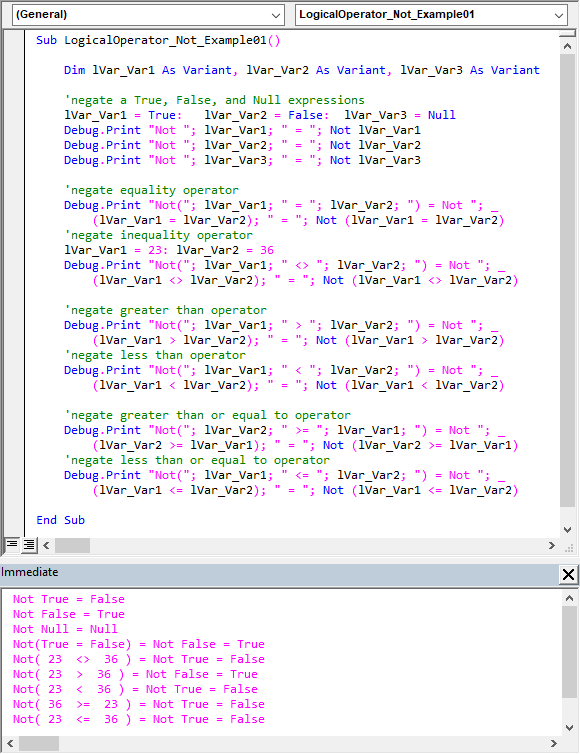
Logical Operators: Conjunction (And)
The sample code below illustrates the logical conjunction (And) operator’s usage.
|
1 2 3 4 5 6 7 8 9 10 11 12 13 14 15 16 17 18 19 20 21 22 23 24 25 26 27 28 29 |
Sub LogicalOperator_And_Example01() Dim lVar_Var1 As Variant, lVar_Var2 As Variant, lVar_Var3 As Variant 'conjunct True, False, and Null expressions lVar_Var1 = True: lVar_Var2 = False: lVar_Var3 = Null Debug.Print lVar_Var1; " And "; lVar_Var1; " = "; _ (lVar_Var1 And lVar_Var1) Debug.Print lVar_Var1; " And "; lVar_Var2; " = "; _ (lVar_Var1 And lVar_Var2) Debug.Print lVar_Var2; " And "; lVar_Var2; " = "; _ (lVar_Var2 And lVar_Var2) Debug.Print lVar_Var1; " And "; lVar_Var3; " = "; _ (lVar_Var1 And lVar_Var3) Debug.Print lVar_Var2; " And "; lVar_Var3; " = "; _ (lVar_Var2 And lVar_Var3) Debug.Print lVar_Var3; " And "; lVar_Var3; " = "; _ (lVar_Var3 And lVar_Var3) 'numeric example lVar_Var1 = 2: lVar_Var2 = 3: lVar_Var3 = 4 Debug.Print vbCrLf; lVar_Var1 < lVar_Var2 And lVar_Var1 > lVar_Var2 'breaking down the inner working of the example operation above Debug.Print lVar_Var1; " < "; lVar_Var2; " And "; lVar_Var1; " > "; _ lVar_Var2; " = "; lVar_Var1 < lVar_Var2; " And "; lVar_Var1 > _ lVar_Var2; " = "; lVar_Var1 < lVar_Var2 And lVar_Var1 > lVar_Var2 End Sub |
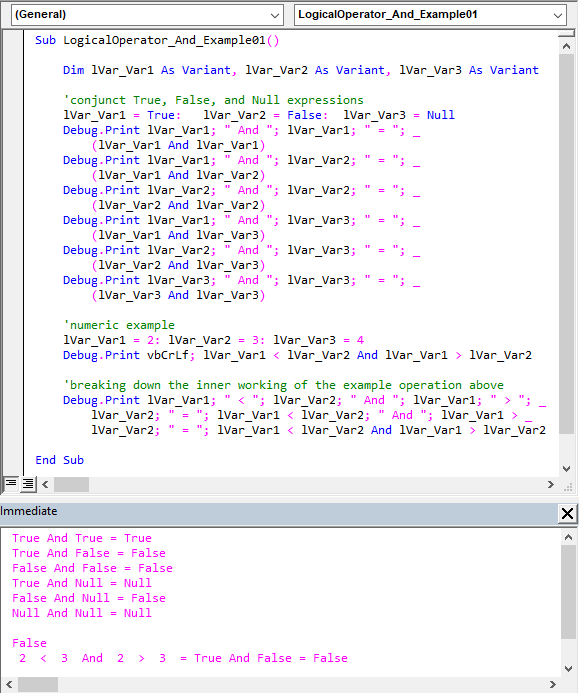
Logical Operators: Disjunction (Or)
The sample code below shows the logical disjunction (Or) operator’s usage.
|
1 2 3 4 5 6 7 8 9 10 11 12 13 14 15 16 17 18 19 20 21 22 23 24 25 26 27 28 29 |
Sub LogicalOperator_Or_Example01() Dim lVar_Var1 As Variant, lVar_Var2 As Variant, lVar_Var3 As Variant 'disjunct True, False, and Null expressions lVar_Var1 = True: lVar_Var2 = False: lVar_Var3 = Null Debug.Print lVar_Var1; " Or "; lVar_Var1; " = "; _ (lVar_Var1 Or lVar_Var1) Debug.Print lVar_Var1; " Or "; lVar_Var2; " = "; _ (lVar_Var1 Or lVar_Var2) Debug.Print lVar_Var2; " Or "; lVar_Var2; " = "; _ (lVar_Var2 Or lVar_Var2) Debug.Print lVar_Var1; " Or "; lVar_Var3; " = "; _ (lVar_Var1 Or lVar_Var3) Debug.Print lVar_Var2; " Or "; lVar_Var3; " = "; _ (lVar_Var2 Or lVar_Var3) Debug.Print lVar_Var3; " Or "; lVar_Var3; " = "; _ (lVar_Var3 Or lVar_Var3) 'numeric example lVar_Var1 = 2: lVar_Var2 = 3: lVar_Var3 = 4 Debug.Print vbCrLf; lVar_Var1 < lVar_Var2 Or lVar_Var1 > lVar_Var2 'breaking down the inner working of the example operation above Debug.Print lVar_Var1; " < "; lVar_Var2; " Or "; lVar_Var1; " > "; _ lVar_Var2; " = "; lVar_Var1 < lVar_Var2; " Or "; lVar_Var1 > _ lVar_Var2; " = "; lVar_Var1 < lVar_Var2 Or lVar_Var1 > lVar_Var2 End Sub |
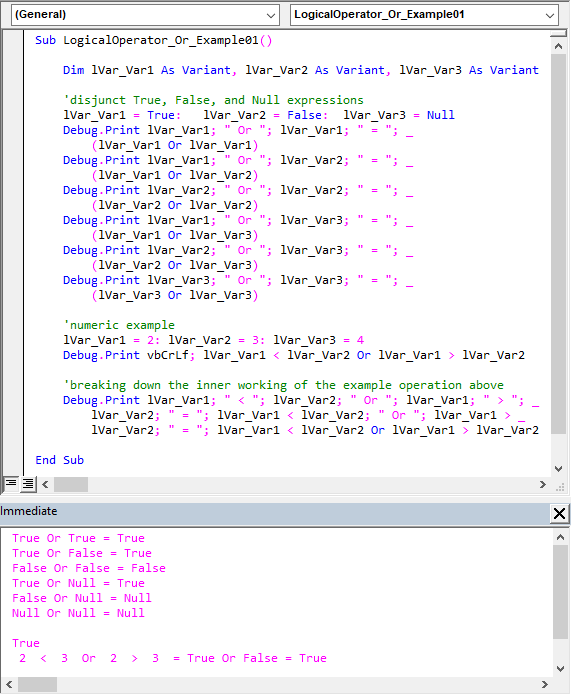
Logical Operators: Exclusion (Xor)
The sample code below illustrates the logical exclusion (Xor) operator’s usage.
|
1 2 3 4 5 6 7 8 9 10 11 12 13 14 15 16 17 18 19 20 21 22 23 24 25 26 27 28 29 |
Sub LogicalOperator_Xor_Example01() Dim lVar_Var1 As Variant, lVar_Var2 As Variant, lVar_Var3 As Variant 'exclusion: True, False, and Null expressions lVar_Var1 = True: lVar_Var2 = False: lVar_Var3 = Null Debug.Print lVar_Var1; " Xor "; lVar_Var1; " = "; _ (lVar_Var1 Xor lVar_Var1) Debug.Print lVar_Var1; " Xor "; lVar_Var2; " = "; _ (lVar_Var1 Xor lVar_Var2) Debug.Print lVar_Var2; " Xor "; lVar_Var2; " = "; _ (lVar_Var2 Xor lVar_Var2) Debug.Print lVar_Var1; " Xor "; lVar_Var3; " = "; _ (lVar_Var1 Xor lVar_Var3) Debug.Print lVar_Var2; " Xor "; lVar_Var3; " = "; _ (lVar_Var2 Xor lVar_Var3) Debug.Print lVar_Var3; " Xor "; lVar_Var3; " = "; _ (lVar_Var3 Xor lVar_Var3) 'numeric example lVar_Var1 = 2: lVar_Var2 = 3: lVar_Var3 = 4 Debug.Print vbCrLf; lVar_Var1 < lVar_Var2 Xor lVar_Var1 > lVar_Var2 'breaking down the inner working of the example operation above Debug.Print lVar_Var1; " < "; lVar_Var2; " Xor "; lVar_Var1; " > "; _ lVar_Var2; " = "; lVar_Var1 < lVar_Var2; " Xor "; lVar_Var1 > _ lVar_Var2; " = "; lVar_Var1 < lVar_Var2 Xor lVar_Var1 > lVar_Var2 End Sub |
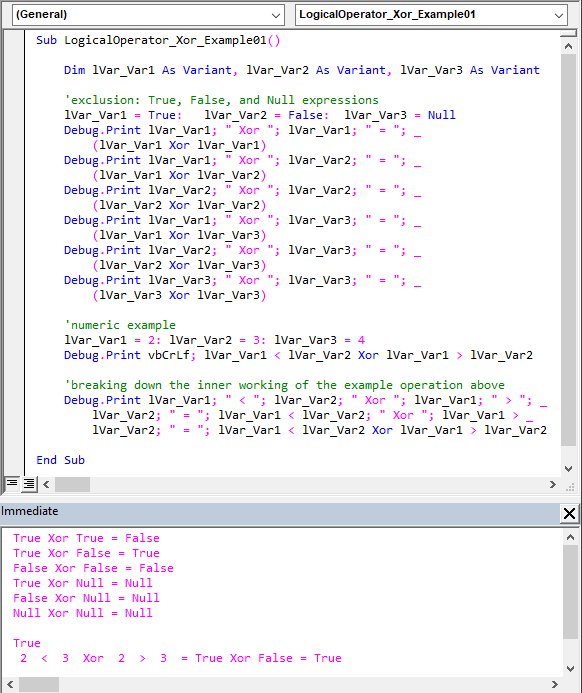
Logical Operators: Equivalence (Eqv)
The sample code below demonstrates the logical exclusion (Eqv) operator’s usage.
|
1 2 3 4 5 6 7 8 9 10 11 12 13 14 15 16 17 18 19 20 21 22 23 24 25 26 27 28 29 |
Sub LogicalOperator_Eqv_Example01() Dim lVar_Var1 As Variant, lVar_Var2 As Variant, lVar_Var3 As Variant 'equivalence: True, False, and Null expressions lVar_Var1 = True: lVar_Var2 = False: lVar_Var3 = Null Debug.Print lVar_Var1; " Eqv "; lVar_Var1; " = "; _ (lVar_Var1 Eqv lVar_Var1) Debug.Print lVar_Var1; " Eqv "; lVar_Var2; " = "; _ (lVar_Var1 Eqv lVar_Var2) Debug.Print lVar_Var2; " Eqv "; lVar_Var2; " = "; _ (lVar_Var2 Eqv lVar_Var2) Debug.Print lVar_Var1; " Eqv "; lVar_Var3; " = "; _ (lVar_Var1 Eqv lVar_Var3) Debug.Print lVar_Var2; " Eqv "; lVar_Var3; " = "; _ (lVar_Var2 Eqv lVar_Var3) Debug.Print lVar_Var3; " Eqv "; lVar_Var3; " = "; _ (lVar_Var3 Eqv lVar_Var3) 'numeric example lVar_Var1 = 2: lVar_Var2 = 3: lVar_Var3 = 4 Debug.Print vbCrLf; lVar_Var1 < lVar_Var2 Eqv lVar_Var1 > lVar_Var2 'breaking down the inner working of the example operation above Debug.Print lVar_Var1; " < "; lVar_Var2; " Eqv "; lVar_Var1; " > "; _ lVar_Var2; " = "; lVar_Var1 < lVar_Var2; " Eqv "; lVar_Var1 > _ lVar_Var2; " = "; lVar_Var1 < lVar_Var2 Eqv lVar_Var1 > lVar_Var2 End Sub |
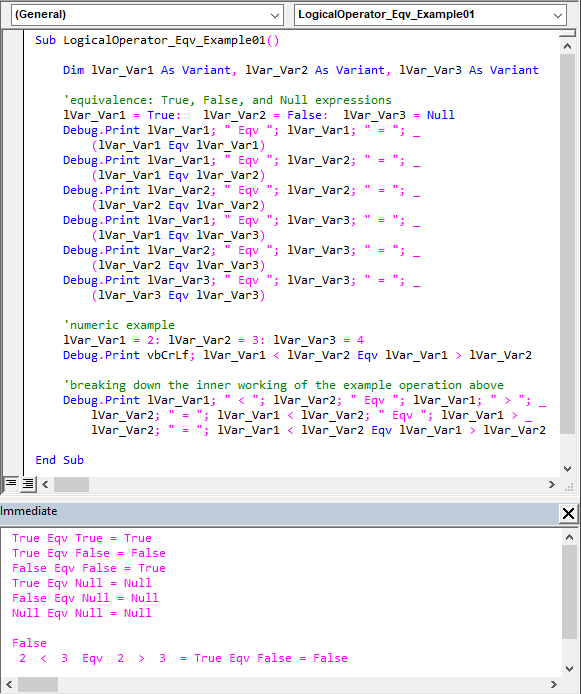
Logical Operator: Implication (Imp)
The sample code below illustrates the logical exclusion (Imp) operator’s usage.
|
1 2 3 4 5 6 7 8 9 10 11 12 13 14 15 16 17 18 19 20 21 22 23 24 25 26 27 28 29 |
Sub LogicalOperator_Imp_Example01() Dim lVar_Var1 As Variant, lVar_Var2 As Variant, lVar_Var3 As Variant 'implication: True, False, and Null expressions lVar_Var1 = True: lVar_Var2 = False: lVar_Var3 = Null Debug.Print lVar_Var1; " Imp "; lVar_Var1; " = "; _ (lVar_Var1 Imp lVar_Var1) Debug.Print lVar_Var1; " Imp "; lVar_Var2; " = "; _ (lVar_Var1 Imp lVar_Var2) Debug.Print lVar_Var2; " Imp "; lVar_Var2; " = "; _ (lVar_Var2 Imp lVar_Var2) Debug.Print lVar_Var1; " Imp "; lVar_Var3; " = "; _ (lVar_Var1 Imp lVar_Var3) Debug.Print lVar_Var2; " Imp "; lVar_Var3; " = "; _ (lVar_Var2 Imp lVar_Var3) Debug.Print lVar_Var3; " Imp "; lVar_Var3; " = "; _ (lVar_Var3 Imp lVar_Var3) 'numeric example lVar_Var1 = 2: lVar_Var2 = 3: lVar_Var3 = 4 Debug.Print vbCrLf; lVar_Var1 < lVar_Var2 Imp lVar_Var1 > lVar_Var2 'breaking down the inner working of the example operation above Debug.Print lVar_Var1; " < "; lVar_Var2; " Imp "; lVar_Var1; " > "; _ lVar_Var2; " = "; lVar_Var1 < lVar_Var2; " Imp "; lVar_Var1 > _ lVar_Var2; " = "; lVar_Var1 < lVar_Var2 Imp lVar_Var1 > lVar_Var2 End Sub |
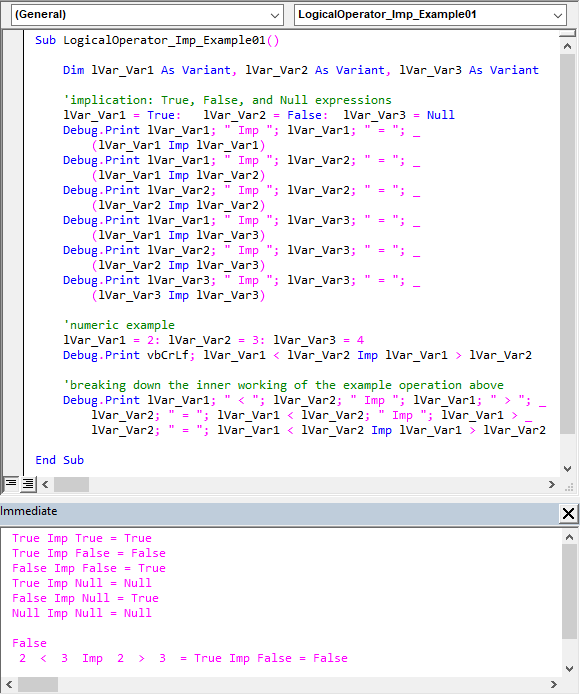
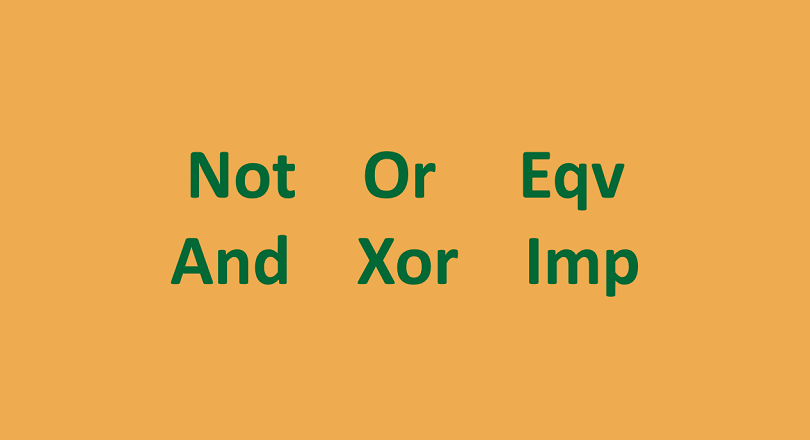

![The While – Wend statement’s syntax. Square brackets, [ ], indicate optional items.](https://masterofficevba.com/wp-content/uploads/2021/03/While_Wend_Statement_Syntaxnew.png)
![The Do – Loop Until statement’s syntax. Square brackets, [ ], indicate optional items while vertical bars, |, indicate mutually exclusive items.](https://masterofficevba.com/wp-content/uploads/2021/03/Do_Loop_Until_Statement_Syntaxnew.png)
![The Do – Loop While statement’s syntax. Square brackets, [ ], indicate optional items while vertical bars, |, indicate mutually exclusive items.](https://masterofficevba.com/wp-content/uploads/2021/03/Do_Loop_While_Statement_Syntaxnew.png)
![The Do Until – Loop statement’s syntax. Square brackets, [ ], indicate optional items.](https://masterofficevba.com/wp-content/uploads/2021/03/Do_Until_Loop_Statement_Syntaxnew.png)
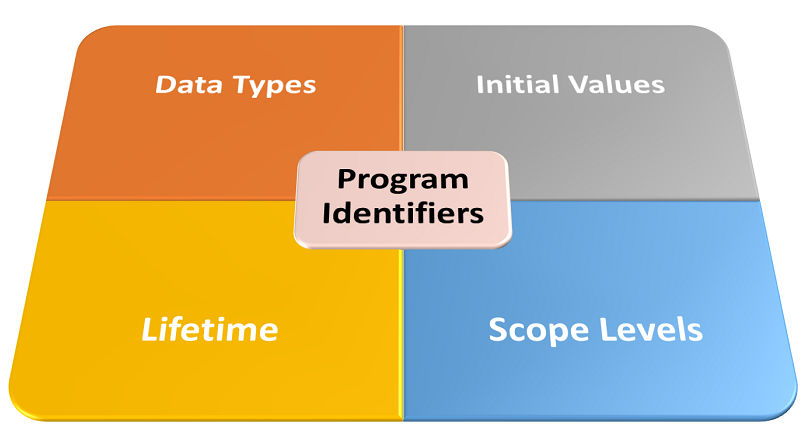





![The While – Wend statement’s syntax. Square brackets, [ ], indicate optional items.](https://masterofficevba.com/wp-content/uploads/2021/03/While_Wend_Statement_Syntaxnew-300x163.png)
![The Do – Loop Until statement’s syntax. Square brackets, [ ], indicate optional items while vertical bars, |, indicate mutually exclusive items.](https://masterofficevba.com/wp-content/uploads/2021/03/Do_Loop_Until_Statement_Syntaxnew-300x163.png)